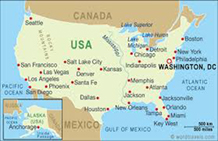EducationUSA is a global network of more than 400 advising centers supported by the Bureau of Educational and Cultural Affairs at the U.S. Department of State.
The Bureau of Educational and Cultural Affairs (ECA) promotes mutual understanding between the United States and other countries through personal and professional ties between private citizens in the United States and abroad, as well as by presenting U.S. history, society, art and culture in all of its diversity to overseas audiences.
TYPES OF INSTITUTIONS
- State universities
- Private universities
- Community Colleges
- Technical and Vocational Colleges
ACADEMIC CALENDAR
The academic year is slightly different for each institution, but normally runs from early September to the end of May. It may either be divided into two terms of 18 weeks called semesters, or “quarters” or “trimesters,” which are about 12 weeks long. There are at least two main holidays during the academic year: a two- to four-week break in the winter (December-January) and a one-week “spring break” some time between early March and mid-April.
TESTS
- Students take standardized tests such as the TOEFL, SAT I, SAT II Subject Tests, ACT, GRE, GMAT, and others.
- Students can also take the Pearson Test of English (PTE) Academic, a computer-based English proficiency test which delivers real-life measures of test takers’ language ability.
- For undergraduate programs, additional tests may include the Scholastic Assessment Test (SAT) Reasoning Test and/or Subject Tests, or the ACT.
- Graduate student applicants interested in short-term university study may be asked to submit scores for the Graduate Record Exam (GRE), General and/or Subject Test.
- Professional short-term programs may require applicants to take a standardized test such as the General or Subject Test of the Graduate Record Exam (GRE), the Graduate Management Admission Test (GMAT), Medical College Admission Test (MCAT), the Optometry Admission Test (OAT), the Dental Admissions Test (DAT), or the Law School Admission Test (LSAT).



